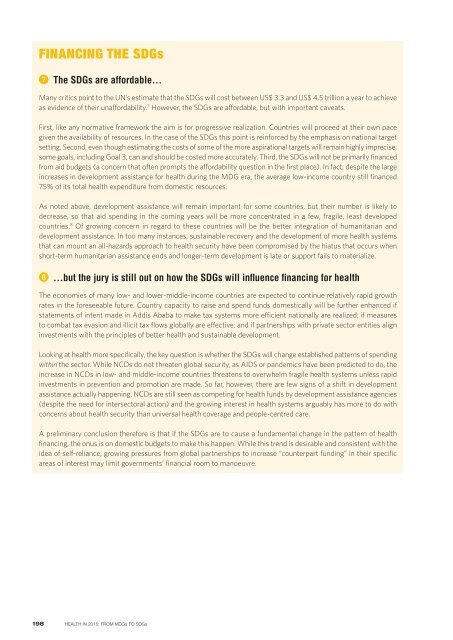Create successful ePaper yourself
Turn your PDF publications into a flip-book with our unique Google optimized e-Paper software.
FINANCING THE SDGs<br />
7 The SDGs are affordable…<br />
Many critics point <strong>to</strong> the UN’s estimate that the SDGs will cost between US$ 3.3 and US$ 4.5 trillion a year <strong>to</strong> achieve<br />
as evidence of their unaffordability. 7 However, the SDGs are affordable, but with important caveats.<br />
First, like any normative framework the aim is for progressive realization. Countries will proceed at their own pace<br />
given the availability of resources. In the case of the SDGs this point is reinforced by the emphasis on national target<br />
setting. Second, even though estimating the costs of some of the more aspirational targets will remain highly imprecise,<br />
some goals, including Goal 3, can and should be costed more accurately. Third, the SDGs will not be primarily financed<br />
<strong>from</strong> aid budgets (a concern that often prompts the affordability question in the first place). In fact, despite the large<br />
increases in development assistance for health during the MDG era, the average low-income country still financed<br />
75% of its <strong>to</strong>tal health expenditure <strong>from</strong> domestic resources.<br />
As noted above, development assistance will remain important for some countries, but their number is likely <strong>to</strong><br />
decrease, so that aid spending in the coming years will be more concentrated in a few, fragile, least developed<br />
countries. 8 Of growing concern in regard <strong>to</strong> these countries will be the better integration of humanitarian and<br />
development assistance. In <strong>to</strong>o many instances, sustainable recovery and the development of more health systems<br />
that can mount an all-hazards approach <strong>to</strong> health security have been compromised by the hiatus that occurs when<br />
short-term humanitarian assistance ends and longer-term development is late or support fails <strong>to</strong> materialize.<br />
8 …but the jury is still out on how the SDGs will influence financing for health<br />
The economies of many low- and lower-middle-income countries are expected <strong>to</strong> continue relatively rapid growth<br />
rates in the foreseeable future. Country capacity <strong>to</strong> raise and spend funds domestically will be further enhanced if<br />
statements of intent made in Addis Ababa <strong>to</strong> make tax systems more efficient nationally are realized; if measures<br />
<strong>to</strong> combat tax evasion and illicit tax flows globally are effective; and if partnerships with private sec<strong>to</strong>r entities align<br />
investments with the principles of better health and sustainable development.<br />
Looking at health more specifically, the key question is whether the SDGs will change established patterns of spending<br />
within the sec<strong>to</strong>r. While NCDs do not threaten global security, as AIDS or pandemics have been predicted <strong>to</strong> do, the<br />
increase in NCDs in low- and middle-income countries threatens <strong>to</strong> overwhelm fragile health systems unless rapid<br />
investments in prevention and promotion are made. So far, however, there are few signs of a shift in development<br />
assistance actually happening. NCDs are still seen as competing for health funds by development assistance agencies<br />
(despite the need for intersec<strong>to</strong>ral action) and the growing interest in health systems arguably has more <strong>to</strong> do with<br />
concerns about health security than universal health coverage and people-centred care.<br />
A preliminary conclusion therefore is that if the SDGs are <strong>to</strong> cause a fundamental change in the pattern of health<br />
financing, the onus is on domestic budgets <strong>to</strong> make this happen. While this trend is desirable and consistent with the<br />
idea of self-reliance, growing pressures <strong>from</strong> global partnerships <strong>to</strong> increase “counterpart funding” in their specific<br />
areas of interest may limit governments’ financial room <strong>to</strong> manoeuvre.<br />
198 HEALTH IN 2015: FROM MDGs TO SDGs


